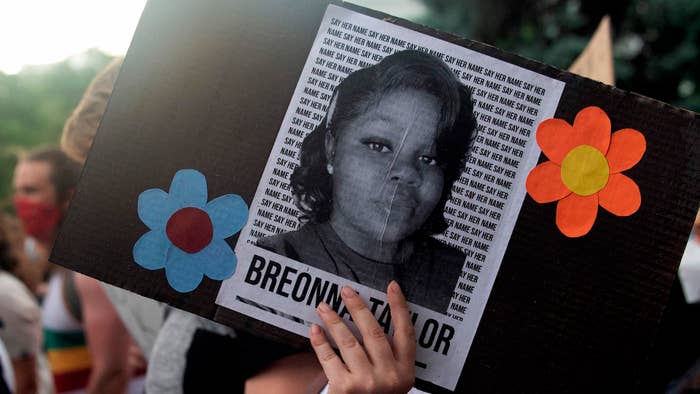
New court documents claim that Breonna Taylor was alive after the police shot her, but was given no medical aid as she lay dying in her apartment, The New York Times reports.
Filed by her family, the 31-page complaint says that she was dying for up to six minutes after the fatal shooting, and modifies an earlier lawsuit against the three officers who opened fire on Taylor’s apartment on March 13. Additionally, the papers assert that the raid was galvanized by a large-scale gentrification redevelopment project spearheaded by Louisville Mayor Greg Fischer.
The coroner, Dr. Barbara Weakley-Jones, who performed the autopsy told NYT that Taylor’s injuries were deadly. “Even if it had happened outside of an ER we couldn’t have saved her,” she said.
The new court docs attempt to give a detailed account of how the white police officers killed the 26-year-old Black woman. Her death led to the firing of one of the involved officers, Brett Hankison and investigations by local and state officials, and the F.B.I. It also prompted the banning of Louisville’s no-knock warrants, which give police the authority to enter people’s homes without informing them.
Both sides agree that the police did knock before entering Taylor’s apartment, but what’s being argued is whether or not the officers identified themselves. The lawsuit says they didn’t, which led Taylor’s companion, Kenneth Walker, to shoot at the officers out of fear, ultimately hitting one in the leg. The officers responded with a cascade of gunfire, hitting Taylor and her home in the process. According to her death certificate, she was struck by five bullets.
“In the six minutes that elapsed from the time Breonna was shot, to the time she died, we have no evidence suggesting that any officer made entry in an attempt to check and assist her,” Sam Aguiar, the family’s lawyer, told NYT. “She suffered.”
State officials disagree, claiming that the cops worked quickly, first looking after the injured officer, then asking Walker to come out. They were only able to go inside the residence after Walker was handcuffed. The officials allege that the police didn’t know Taylor was injured since the shooting happened in near darkness.
According to 911 calls, the shooting started at 12:42 a.m., but Taylor’s death certificate showed her time of death as “approximately 12:48.” Officials say the earliest time paramedics were able to enter the apartment was 12:54 a.m., after Walker exited and the officer was taken to a hospital. Phone records also show that Walker dialed 911 at 12:47 a.m. and reported Taylor’s injuries, at which point she wasn’t alert or able to speak.
The Times reports that when asked about Taylor’s time of death and the 6-minute gap, the coroner said that her deputy who logged the death certificate hadn’t been shown how to read autopsy reports.
In the complaint, Aguiar listed a number of violations that led to her death, including the police relying on old intelligence. The search warrant indicated that the targeted drug dealer, Jamarcus Glover, was visiting Taylor and had used her apartment as his home address—but the docs contend that those findings were from January and February. Authorities also mistakenly thought her Dodge Charger was Glover’s car. Glover was reportedly Taylor’s ex-boyfriend.
Police reportedly broke other protocols, like not having an ambulance on standby during the raid, which is “common practice” during high-risk warrants, according to Jessie Halladay, an LMPD spokeswoman. While an emergency log shows that an ambulance was dispatched to Taylor’s home at 11:12 p.m., it didn’t leave until 11:39 p.m. At 12:44 a.m., after the shooting, the log read: “PD NEEDS EMS NOW.”
It’s unclear which gunshots ultimately killed Taylor. “We have concerns about where the five bullets came from, who fired and where they originated,” Aguiar said. “We have reason to believe that at least one of the shots that struck her came from outside her house.” It’s thought that Officer Hankison—who was fired—was standing in that spot.
Moreover, the lawsuit claims that the police were looking for Glover because of the mayor’s multimillion-dollar gentrification redevelopment plan. Glover was allegedly squatting in abandoned homes in the city, where he was housing and selling drugs in an area that was set to be rebuilt. That night, police searched Taylor’s home and four other premises in an attempt to find Glover.
“People needed to be removed and homes needed to be vacated so that a high-dollar, legacy-creating real estate development could move forward,” the court filing said. However, city officials deny the allegations calling them “outrageous” and “without foundation,” said Jean Porter, a spokeswoman for Mayor Fischer. Officials say that the project was public knowledge and received funding from federal grants totaling over $30 million.
The lawsuit also states that the LMPD created a unit called Placed Based Investigations, which the docs say was “tasked with focusing on certain areas which needed to be cleared for real estate development projects to proceed.” The PBI was specifically told to commit resources and time to Elliott Avenue, the street on which Glover rented a home—and the street that the mayor was eyeing to be one of his “last chances” to sustain the project, as it was failing.
CBS News writes that on the night of Taylor’s death, “despite learning about apprehending Glover at a location on Elliot Avenue earlier,” LMPD still went ahead and executed the search warrant at her home on Springfield Drive.

